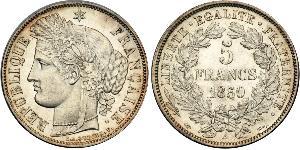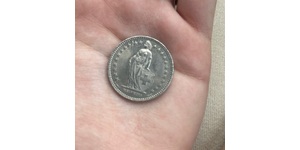5 Franc (售价 $40.0)
1830, France (2nd Kingdom), Louis-Philippe. Silver 5 Francs Coin. (VF+) Rouen!
Mint Year: 1836 Mint Place: Rouen (B) Denomination: 5 Francs Condition: A nicely toned VF+ Reference: KM-735.2 ($85 in VF!). Diameter: 37mm Material: Silver Weight: 25gm
Obverse: Bare bust of King Louis-Philippe I right. Designer´s signature (N.P.TIOLIER) inside head truncation. Legend: LOUIS PHILIPPE I ROI DES FRANCAIS.
Reverse: Denomination (5 FRANCS) and date (1830) flanked by mint letter and privy mark at sides. Star below. All within wreath. Legend: 5 / FRANCS / (mint letter: B) 1830 (privy mark: lamb of god)
Louis-Philippe (6 October 1773 – 26 August 1850), was King of the French from 1830 to 1848 in what was known as the July Monarchy. He was the last king to rule France, although Napoleon III, styled as an emperor, would serve as its last monarch.
Louis Philippe d'Orléans was born at the Palais Royal in Paris to Louis Philippe Joseph, Duke of Chartres (later Duke of Orléans and, later still, known as Philippe Egalité) and Louise Marie Adélaïde de Bourbon-Penthièvre. As a member of the reigning House of Bourbon, he was a Prince du Sang. He was the first of three sons and a daughter of the Orléans family, a family that was to have erratic fortunes for the next court years.
In 1830, the July Revolution overthrew Charles X. Charles abdicated in favor of his 10-year-old grandson, Henri, Duke of Bordeaux. Louis Philippe was charged by Charles X to announce to the popularly elected Chamber of Deputies his desire to have his grandson succeed him. Louis Philippe did not do this, in order to increase his own chances of succession. As a consequence, because the chamber was aware of Louis Philippe's Liberal policies and his popularity with the masses, they proclaimed Louis Philippe, who for 11 days had been acting as the regent for his small cousin, as the new French king, displacing the senior branch of the House of Bourbon.
In anger over this betrayal, Charles X and his family, including his grandson, left for Great Britain. The grandson, better known as the Henri, Comte de Chambord, later became the pretender to Louis Philippe's throne and was supported by many nobles known as Legitimists.
Upon accession, Louis Philippe assumed the title of King of the French - a title already employed in the short-lived Constitution of 1791. Linking the monarchy to a people instead of a territory (as the previous designation King of France and Navarra) aimed at undercutting the Legitimist claims of Charles X and his family.
By his ordinance of 13 August 1830, soon after his accession to the throne, it was decided that the king's sister and his children would continue to bear the arms of Orléans, that Louis Philippe's eldest son, as Prince Royal, would bear the title Duke of Orléans, that the younger sons would continue to have their previous titles, and that the sister and daughters of the king would only be styled Princesses of Orléans, not of France.
In 1832, his daughter, Princess Louise-Marie (1812–1850), married the first ruler of Belgium, Leopold I, King of the Belgians.
In July 1835 Louis Philippe survived an assassination attempt by Giuseppe Mario Fieschi on the boulevard du Temple in Paris.
In 1831, his son and heir, Ferdinand Philippe, Duke of Orléans, died in a carriage accident.
Louis Phillippe ruled in an unpretentious fashion, avoiding the pomp and lavish spending of his predecessors. Despite this outward appearance of simplicity, his support came from the wealthy middle classes. At first, he was much loved and called the "Citizen King" and the "bourgeois monarch," but his popularity suffered as his government was perceived as increasingly conservative and monarchical, despite his return of Napoleon's remains to France. Under his management the conditions of the working classes deteriorated, and the income gap widened considerably. An economic crisis in 1847 led to the citizens of France revolting against their king again the following year.
On 24 February 1848, during the February 1848 Revolution, to general surprise, King Louis Philippe abdicated in favor of his nine-year-old grandson, Philippe. Fearful of what had happened to Louis XVI, Louis Philippe quickly disguised himself and fled Paris. Riding in an ordinary cab under the name of "Mr. Smith", he escaped to England. According to The Times of 6 March 1848, the King and Queen were received at Newhaven, East Sussex before travelling by train to London.
The National Assembly initially planned to accept young Philippe as king, but the strong current of public opinion rejected that. On 26 February, the Second Republic was proclaimed. Prince Louis Napoleon Bonaparte was elected President in December; a few years later he declared himself president for life and then Emperor Napoleon III.
Louis Philippe and his family lived in England until his death in Claremont, Surrey. He is buried with his wife, Amelia (26 April 1782–24 March 1866), at the Chapelle royale de Dreux, the family necropolis his mother had built in 1816, in Dreux.

|
发布人:
anonymous 2021-08-25 |
|
||
|
||
|
||
|
||
|
||

-600-300-tTKKqnZSt4YAAAF7TDQ1lHvp.jpg)

-300-150-iRsKbzbisCwAAAFRgHNauwmb.jpg)
 Deutsch
Deutsch Русский
Русский Українська
Українська English
English Italiano
Italiano Français
Français Español
Español 汉语
汉语












